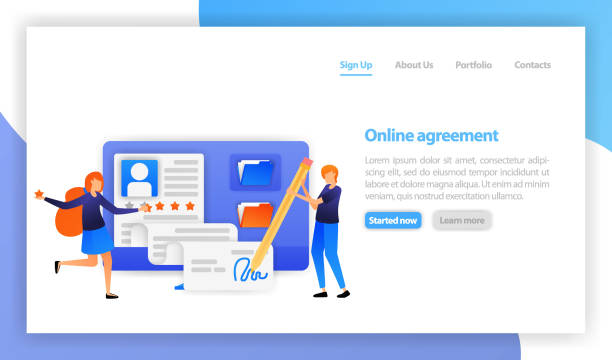Introduction to Secure Website Design and Its Necessity

In today’s world, where information technology plays a pivotal role in all aspects of our lives, secure website design is no longer a luxury option but a vital necessity.
Every day, we witness an increase in #cyber_attacks, #data_theft, and #privacy_breaches, which can have irreparable consequences for individuals and businesses.
An insecure website not only exposes sensitive user information to risk but can also severely damage the #credibility and #trust of a brand.
This issue is particularly critical for commercial, banking, educational, and governmental websites that process vast amounts of confidential data.
Cybersecurity in website design and development must be considered from the very initial stages and should not be postponed to the final phases.
The “Security by Design” approach means incorporating security considerations at every step of the development process, from system architecture design to code implementation and final deployment.
This approach significantly helps prevent vulnerabilities and drastically reduces potential costs arising from post-intrusion remediation.
It is crucial to understand that an insecure website can jeopardize not only the organization’s own data but also the data of customers, partners, and stakeholders.
Secure website design means creating a multi-layered defense that protects all aspects of the website, from the client to the server and database.
This includes the use of encryption technologies, secure communication protocols, strong authentication mechanisms, and precise access management.
The ultimate goal is to create a trustworthy and threat-resistant online environment.
(Explanatory and Educational)
Are you bothered by losing customers due to your online store’s outdated appearance or slow speed? Rasawp’s expert team solves these problems with professional e-commerce website design!
✅ Increase customer trust and your brand’s credibility
✅ Blazing speed and excellent user experience
Get a free consultation with Rasawp now ⚡
Identifying and Understanding Common Web Vulnerabilities

To ensure secure website design, a thorough understanding of common web vulnerabilities is essential.
One of the most prevalent vulnerabilities is SQL Injection, which allows attackers to gain access to the database and manipulate or delete information by injecting malicious SQL code into user inputs.
This attack can lead to the theft of sensitive user data or even complete control over the database server.
Another vulnerability is Cross-Site Scripting (XSS), where attackers inject malicious JavaScript code into the website.
These codes execute in the victim’s browser and can steal user session information (Session Cookies), alter website content, or even redirect the user to phishing sites.
The OWASP Top 10 project regularly publishes a list of the top 10 web security vulnerabilities that developers should pay special attention to.
This list includes items such as Broken Authentication, Insecure Deserialization, and Security Misconfiguration.
Broken Authentication allows attackers to gain unauthorized access to user accounts by bypassing authentication systems.
Insecure Direct Object References occur when developers use direct identifiers to access objects and do not apply proper access control, which can lead to unauthorized access to information or resources.
To combat these threats, developers must not only be familiar with these vulnerabilities but also continuously update their knowledge of new attack and defense techniques.
Understanding these fundamental principles is vital for anyone looking to achieve secure website design that is resilient against threats.
(Technical and Educational)
Principles and Best Practices for Secure Coding

The process of secure website design requires strict adherence to secure coding principles.
One of the most important of these principles is Input Validation.
All data received from the user, without exception, must be validated to prevent the injection of malicious code and attacks such as SQL Injection and XSS.
This validation should be performed on both the client side and the server side so that even if client-side validation is bypassed, the server can identify and reject suspicious data.
Using Prepared Statements or parameterizing queries when interacting with the database is a highly effective solution for preventing SQL Injection.
This method ensures that user input is treated as data and not as part of SQL commands.
Table 1: Comparison of Secure and Insecure Coding Methods
| Feature | Insecure Method (High Risk) | Secure Method (Recommended) |
|---|---|---|
| Input Validation | Client-side only or no validation | Comprehensive client-side and server-side validation |
| Database Interaction | Building queries with String Concatenation | Using Prepared Statements / ORM |
| Session Management | Session ID in URL or no expiration | Session ID in HttpOnly/Secure cookies, regular expiration |
| Error Handling | Displaying detailed and information-revealing error messages | Displaying general error messages and logging errors |
| Password Management | Storing passwords in plain text or weak hash | Strong hashing with Salt (e.g., bcrypt) |
Furthermore, secure Session Management is also very important.
Session IDs should not be displayed in the URL, and HttpOnly and Secure cookies should be used to prevent XSS attacks.
Additionally, setting appropriate expiration times for sessions and generating session IDs in an encrypted and unpredictable manner helps secure the website.
Error handling must also be done carefully; general error messages should be displayed to the user, and technical details should be logged in server log files, rather than being shown directly to the user, as this information can be exploited by attackers to identify vulnerabilities.
Always remember that in the process of website security, one should never rely on “Security by Obscurity”; instead, known security principles and standards must be followed.
(Guidance and Technical)
The Role of SSL/TLS Certificates in Securing Communications

In the path of secure website design, the use of HTTPS protocol with SSL/TLS certificates is a fundamental and indispensable step.
SSL (Secure Sockets Layer) and its successor TLS (Transport Layer Security) are protocols that encrypt the communication between the user’s browser and the website server.
This encryption protects information such as usernames, passwords, credit card details, and other sensitive data from eavesdropping and tampering by third parties during transmission.
Without HTTPS, data is sent in plain text, and anyone with network access can easily intercept and read it, which is the most dangerous scenario for user privacy.
An SSL/TLS certificate is issued by a Certificate Authority (CA) and verifies the website’s identity.
When a user connects to a website with HTTPS, their browser checks the certificate to ensure its validity.
The presence of a green lock icon in the browser’s address bar indicates a secure and trustworthy connection.
This not only enhances security but also builds user trust and positively impacts the website’s SEO, as search engines like Google prefer HTTPS-enabled websites in their ranking.
The choice of certificate type (Domain Validated, Organization Validated, Extended Validation) depends on the level of trust the website requires; for instance, EV certificates offer the highest level of identity verification.
Correct installation and configuration of SSL/TLS are also of paramount importance.
It must be ensured that all website resources (images, CSS files, JavaScript, etc.) are also loaded via HTTPS to prevent “Mixed Content” errors.
This is a fundamental pillar in building a secure website.
(Explanatory and Educational)
Tired of losing business opportunities due to not having a professional corporate website? Don’t worry anymore! With Rasawp’s corporate website design services:
✅ Your brand’s credibility and professionalism will increase.
✅ You will attract more customers and sales leads.
⚡ Get a free consultation right now to get started!
Server and Infrastructure Security: Key to Secure Website Design

Secure website design is not limited to coding alone; the security of the server and hosting infrastructure is also of vital importance.
Server Hardening refers to applying a set of configurations and settings to reduce the attack surface and increase the server’s resistance to intrusion.
This includes removing unnecessary services and applications, closing unused ports, and precisely configuring firewalls.
A strong firewall can filter malicious traffic and allow only authorized traffic to pass through.
Regularly updating the operating system, web server (such as Apache or Nginx), and all installed software on the server is one of the simplest yet most effective security measures.
Many attacks occur by exploiting known vulnerabilities in outdated software that can be patched with security updates.
Web Application Firewalls (WAFs) can also provide an additional layer of security and block common web attacks like SQL Injection and XSS at the network level.
Furthermore, Access Control to the server must be performed with great care.
Only authorized individuals should have server access, and the Principle of Least Privilege should be followed, meaning that each user or service only has access to the resources necessary for their tasks.
Using strong authentication like SSH keys instead of passwords for administrative access significantly increases security.
Continuous monitoring of server logs to identify suspicious activities is also an important part of the website infrastructure security strategy.
All these measures together help create a stable and secure platform for your website.
(Technical and Guidance)
Protecting Databases: The Heart of Every Website

The database is the beating heart of every website, storing sensitive user information and the core functionality of the application.
Therefore, protecting it is a top priority in secure website design.
The first step in securing a database is data encryption.
Sensitive data such as passwords (which should be hashed and salted), credit card information, and other personal data must be encrypted both at rest and in transit.
Using strong encryption algorithms and securely managing encryption keys is of paramount importance.
Strict access control to the database is also crucial.
Every user or service connecting to the database must have the principle of least privilege.
For example, a website service that only needs to read and write specific information should not have administrative access to the entire database.
Default user accounts with weak or default passwords should be immediately changed or deleted.
Implementing a firewall at the database level can also prevent unauthorized access to database ports and allow connections only from authorized IP addresses.
Regular and secure backups of the database are also a proactive security measure that allows for quick recovery in case of an attack or data loss.
These backups should be stored in a secure location separate from the main server.
Monitoring database activities and reviewing logs to identify suspicious access patterns can quickly reveal intrusions.
All these measures together ensure the security of your website’s data and are an integral part of a comprehensive approach to secure website design.
(Technical and Guidance)
Powerful Authentication and Authorization Mechanisms

Establishing powerful Authentication and Authorization mechanisms is a cornerstone of secure website design.
Authentication is the process of verifying a user’s identity, while authorization determines what resources the authenticated user has access to.
Using strong password policies that include minimum length, a mix of uppercase and lowercase letters, numbers, and symbols, is the first step.
Additionally, users should be encouraged to change their passwords periodically, and storing passwords in plain text or weak hashes should be avoided; using one-way hashing algorithms with Salt (like bcrypt or Argon2) is essential.
Table 2: Authentication Methods and Their Characteristics
| Authentication Method | Advantages | Disadvantages / Security Considerations |
|---|---|---|
| Username and Password | Simple and common | Vulnerable to Brute Force and Dictionary attacks, requires strong password policy |
| Two-Factor Authentication (2FA/MFA) | Significantly increased security, even if password is compromised | Requires a second device, more complexity for the user |
| Single Sign-On (SSO) | Convenience for user, centralized management | Single Point of Failure, attractive target for attackers |
| Biometric Authentication | Convenience, high security (for some methods) | Implementation complexity, privacy concerns, possibility of forgery (in rare cases) |
Multi-Factor Authentication (MFA), including Two-Factor Authentication (2FA), adds a critical layer of security.
This method requires the user to provide, in addition to their password (something they know), another factor such as a code sent to their mobile phone (something they have) or a fingerprint (something they are).
This significantly complicates unauthorized access even if the password is compromised.
MFA implementation should be designed not to overly burden the user, to avoid disrupting the user experience.
In terms of authorization, Role-Based Access Control (RBAC) or Attribute-Based Access Control (ABAC) mechanisms should be used.
These mechanisms ensure that each user only has access to those parts of the website or data defined for their specific role or attributes.
Correct implementation of these mechanisms prevents unauthorized internal or external access and significantly strengthens website security.
User session management must also be done carefully, including regular session expiration, generation of unpredictable session IDs, and the use of secure cookies.
(Technical and Guidance)
The Importance of Security Audits and Periodic Penetration Testing

No secure website design, no matter how carefully done, can claim to be 100% secure.
Cyber threats are constantly evolving, and new vulnerabilities are discovered.
Therefore, performing regular security audits and penetration tests is of vital importance.
A security audit involves a comprehensive review of the code, server configuration, and security processes to identify potential weaknesses.
These audits can be performed internally or by external specialized companies.
Penetration testing, often referred to as “ethical hacking,” is a controlled simulation of a real cyber attack performed by security experts (white-hat hackers).
The goal of this test is to find vulnerabilities that might have been overlooked during development or regular audits.
These tests can include black-box testing (without prior knowledge of the system), white-box testing (with full access to code and documentation), or gray-box testing (with limited knowledge).
Penetration test reports not only identify vulnerabilities but also provide recommendations for fixing them and improving the overall system security.
These tests should be repeated periodically, especially after major system changes or the addition of new functionalities.
The results of these tests help the development team address weaknesses and make the website more resilient against potential attacks.
The importance of this proactive approach is that it takes away opportunities from malicious attackers and allows the organization to resolve its issues before a serious security incident occurs.
This is an important analytical aspect in the website security process and assures managers that their investment in secure website design has been properly made.
(Analytical and Guidance)
Research shows that 80% of customers trust companies with professional websites more. Does your current website inspire this trust?
With Rasawp’s corporate website design services, permanently solve the problem of customer distrust and weak online image!
✅ Create a professional image and increase customer trust
✅ Attract more sales leads and business growth
⚡ Get a free consultation
Security Incident Management and Response to Intrusion

Even with the best secure website design and the strongest defense mechanisms, there is no 100% guarantee against intrusion.
Cyber threats are constantly changing and becoming more sophisticated.
Therefore, having a comprehensive Security Incident Management Plan (Incident Response Plan) is absolutely essential for any organization with a website.
This plan should include specific steps for identification, containment, eradication, recovery, and post-incident analysis following a security incident.
The first stage is identification; monitoring systems and intrusion detection/prevention tools (IDS/IPS) should be able to detect suspicious activities early on.
After identification, the primary goal is to contain the attack to prevent further damage.
This may involve cutting off the attacker’s access, isolating infected systems, or even, in emergencies, taking a part of the website offline.
The eradication stage involves a detailed analysis of the incident to find the root cause of the vulnerability that the attacker exploited.
This stage is crucial to prevent the incident from recurring in the future.
Then, the recovery process begins, which includes cleaning up systems, restoring data from secure backups, and ensuring all services function correctly.
Finally, a Post-Mortem Analysis is conducted to learn from the incident and improve future security processes.
This process should involve thorough documentation of all steps and decisions made.
Transparency in incident reporting, especially if user data has been affected, is also of high importance and can help maintain user trust.
The security incident response team should be regularly trained and conduct simulated drills to ensure fast and effective performance in real-time.
Having a clear communication protocol with stakeholders (users, media, regulatory bodies) during an incident is also essential.
This readiness, even in the face of worst-case scenarios, helps maintain website security and credibility.
(Informative and Guidance)
The Future of Secure Website Design and Upcoming Challenges

As technology advances, the landscape of secure website design undergoes significant transformations.
Artificial intelligence and machine learning play an increasing role in cybersecurity; from identifying suspicious behavioral patterns and anomaly detection to automating threat responses.
But does this mean the end of security challenges? Here’s the thought-provoking content: as AI advances in defense, won’t attackers also use AI to develop more sophisticated attacks? This is an endless arms race.
Web 3.0 and blockchain technology also bring new challenges and opportunities for web security.
While blockchain, due to its decentralized and encrypted nature, promises greater security, smart contracts themselves can have vulnerabilities and require rigorous auditing.
These areas require deep analysis and novel approaches to security.
Increased use of APIs (Application Programming Interfaces) and microservices has also added new layers of complexity to web security; each API must be carefully secured to avoid creating new entry points for attackers.
New threats such as supply chain attacks, where attackers infiltrate software used in the development process, as well as quantum threats that have the potential to break current encryptions, all pose serious challenges to the future of web security.
The development of Quantum-Safe Cryptography is currently underway.
For secure website design to remain effective, developers, system architects, and security managers must continuously update their knowledge and stay familiar with the latest trends and technologies.
This is an endless journey of learning and adaptation that can be very entertaining and dynamic for those interested in the field of security.
(Analytical, Entertaining, and Thought-Provoking Content)
Frequently Asked Questions
| Row | Question | Answer |
|---|---|---|
| 1 | What is secure website design? | Secure website design is a process in which websites are built with security measures in mind from the initial stages of development to protect against cyberattacks, unauthorized access, and data loss. |
| 2 | Why is secure website design important? | Website security is crucial for maintaining user trust, protecting sensitive information (personal and financial), preventing damage to brand reputation, and complying with privacy and security regulations (such as GDPR). A security breach can lead to financial and legal damages. |
| 3 | What are the most common cyberattacks a website faces? | Some of the most common attacks include SQL Injection, Cross-Site Scripting (XSS), Distributed Denial of Service (DDoS), Brute Force, and credential-based attacks (Credential Stuffing). |
| 4 | What is SQL Injection and how can it be prevented? | SQL Injection is a type of attack where an attacker attempts to manipulate the database or extract information by injecting malicious SQL code into site inputs. To prevent it, one should use Prepared Statements/Parameterized Queries, ORM (Object-Relational Mapping), and strict input validation. |
| 5 | What is Cross-Site Scripting (XSS)? | XSS is a type of attack where an attacker injects malicious scripts (usually JavaScript) into web pages that are executed by other users’ browsers. This can lead to the theft of cookies, session information, or alteration of the website’s appearance. |
| 6 | How can Brute Force attacks on login pages be prevented? | To prevent Brute Force attacks, CAPTCHA, limiting the number of failed login attempts (Account Lockout), Two-Factor Authentication (2FA), and using complex and long passwords should be employed. |
| 7 | What is the role of HTTPS in website security? | HTTPS uses SSL/TLS to encrypt communication between the user’s browser and the website server. This prevents eavesdropping, tampering, or forgery of information during transmission and increases user trust. |
| 8 | What is the importance of Input Validation in security? | Input Validation is the process of checking and sanitizing data entered by the user. This prevents the injection of malicious code, XSS attacks, SQL Injection, and other vulnerabilities, ensuring that data conforms to the expected format. |
| 9 | Why is regular updating of website systems and software necessary? | Regular updates of the operating system, CMS (like WordPress), plugins, themes, and libraries used, fix known security vulnerabilities. Hackers often exploit weaknesses in outdated software for intrusion. |
| 10 | What role do regular backups play in secure website design? | Regular and tested backups of website information (database and files) are a vital layer of defense against data loss due to cyberattacks, human error, or hardware failure. This allows for quick website recovery in case of a disaster. |
And other services of Rasawp Advertising Agency in the field of advertising
Smart Digital Advertising: A new service for increasing customer acquisition through the use of real data.
Smart Conversion Rate Optimization: Designed for businesses seeking online growth through user experience customization.
Smart Social Media: A specialized service for increasing sales growth based on SEO-driven content strategy.
Smart Conversion Rate Optimization: A fast and efficient solution for online growth focusing on Google Ads management.
Smart Content Strategy: A new service for increasing campaign management through custom programming.
And over hundreds of other services in the field of internet advertising, advertising consultation, and organizational solutions
Internet Advertising | Advertising Strategy | Advertorial
Resources
Security Tips in the Digital Age
Comprehensive Web Security Guide
Cyber Threat Review
Importance of SSL Certificate on Website
? To shine in the digital world and reach the peak of success, Rasawp Afarin Digital Marketing Agency is by your side with its comprehensive services, including responsive website design.
📍 Tehran, Mirdamad Street, next to Bank Markazi, Southern Kazeroon Alley, Ramin Alley, No. 6



